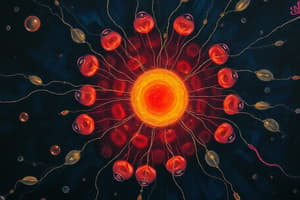Podcast
Questions and Answers
Which type of solution refers to a solution that has the same potential osmotic pressure as the cell?
Which type of solution refers to a solution that has the same potential osmotic pressure as the cell?
- Isotonic (correct)
- Exocytosis
- Endocytosis
- Hypotonic
What is the process that involves the movement of molecules from a region of lower concentration to a region of higher concentration against a gradient or an obstacle with the use of external energy?
What is the process that involves the movement of molecules from a region of lower concentration to a region of higher concentration against a gradient or an obstacle with the use of external energy?
- Exocytosis
- Active Transport (correct)
- Hypertonic
- Osmosis
What is the movement of water molecules from a solution with a high concentration of water molecules to a solution with a lower concentration of water molecules, through a cell's partially permeable membrane?
What is the movement of water molecules from a solution with a high concentration of water molecules to a solution with a lower concentration of water molecules, through a cell's partially permeable membrane?
- Active Transport
- Exocytosis
- Hypertonic
- Osmosis (correct)
What is the process by which cells move materials from within the cell into the extracellular fluid?
What is the process by which cells move materials from within the cell into the extracellular fluid?
What is the function of the condenser in a microscope?
What is the function of the condenser in a microscope?
What should be done after attaining a clear image with the lowest magnification objective lens?
What should be done after attaining a clear image with the lowest magnification objective lens?
What is the purpose of moving the coarse adjustment knob while looking through the eyepiece?
What is the purpose of moving the coarse adjustment knob while looking through the eyepiece?
What is the purpose of adjusting the diaphragm or condenser knob when using higher objective lenses?
What is the purpose of adjusting the diaphragm or condenser knob when using higher objective lenses?
What does the plasma membrane do?
What does the plasma membrane do?
What is the fluid mosaic model of membrane structure?
What is the fluid mosaic model of membrane structure?
What is the function of the glycocalyx?
What is the function of the glycocalyx?
What is the function of gap junctions?
What is the function of gap junctions?
What is the function of peroxisomes in the cell?
What is the function of peroxisomes in the cell?
What is the main function of centrioles in the cell?
What is the main function of centrioles in the cell?
What is the composition of intermediate filaments in the cell?
What is the composition of intermediate filaments in the cell?
What is the key characteristic that distinguishes microvilli from cilia?
What is the key characteristic that distinguishes microvilli from cilia?
Study Notes
Osmosis and Cell Transport
- An isotonic solution has the same potential osmotic pressure as the cell.
- Active transport is the process that involves the movement of molecules from a region of lower concentration to a region of higher concentration against a gradient or an obstacle, using external energy.
Osmosis
- Osmosis is the movement of water molecules from a solution with a high concentration of water molecules to a solution with a lower concentration of water molecules, through a cell's partially permeable membrane.
Exocytosis
- Exocytosis is the process by which cells move materials from within the cell into the extracellular fluid.
Microscopy
- The condenser in a microscope focuses light onto the sample.
- After attaining a clear image with the lowest magnification objective lens, the next step is to switch to a higher magnification objective lens.
- The coarse adjustment knob is used to bring the image into focus while looking through the eyepiece.
- The diaphragm or condenser knob is adjusted when using higher objective lenses to optimize the amount of light entering the microscope.
Cell Structure and Function
- The plasma membrane serves as a selective barrier, controlling what enters and leaves the cell.
- The fluid mosaic model of membrane structure describes the membrane as a dynamic, flexible structure composed of a phospholipid bilayer with embedded proteins.
- The glycocalyx is a carbohydrate-rich region on the outside of the plasma membrane that plays a role in cell-cell interactions and signaling.
- Gap junctions are specialized channels that allow direct communication and exchange of molecules between adjacent cells.
- Peroxisomes are organelles responsible for breaking down fatty acids and amino acids.
- Centrioles are involved in the formation of cilia, flagella, and spindle fibers during cell division.
- Intermediate filaments are composed of a variety of proteins, such as keratin, vimentin, and lamin, that provide mechanical support and structure to the cell.
- Microvilli are small, finger-like projections that increase the surface area of the cell, whereas cilia are longer, more complex structures involved in movement and sensing.
Studying That Suits You
Use AI to generate personalized quizzes and flashcards to suit your learning preferences.
Description
Test your knowledge of cell biology with this quiz covering the cytoskeleton and organelles such as microfilaments, peroxisomes, and intermediate filaments. Explore the functions and roles of these cellular components in muscle contraction, intracellular movement, enzyme detoxification, and stabilization against mechanical forces.




